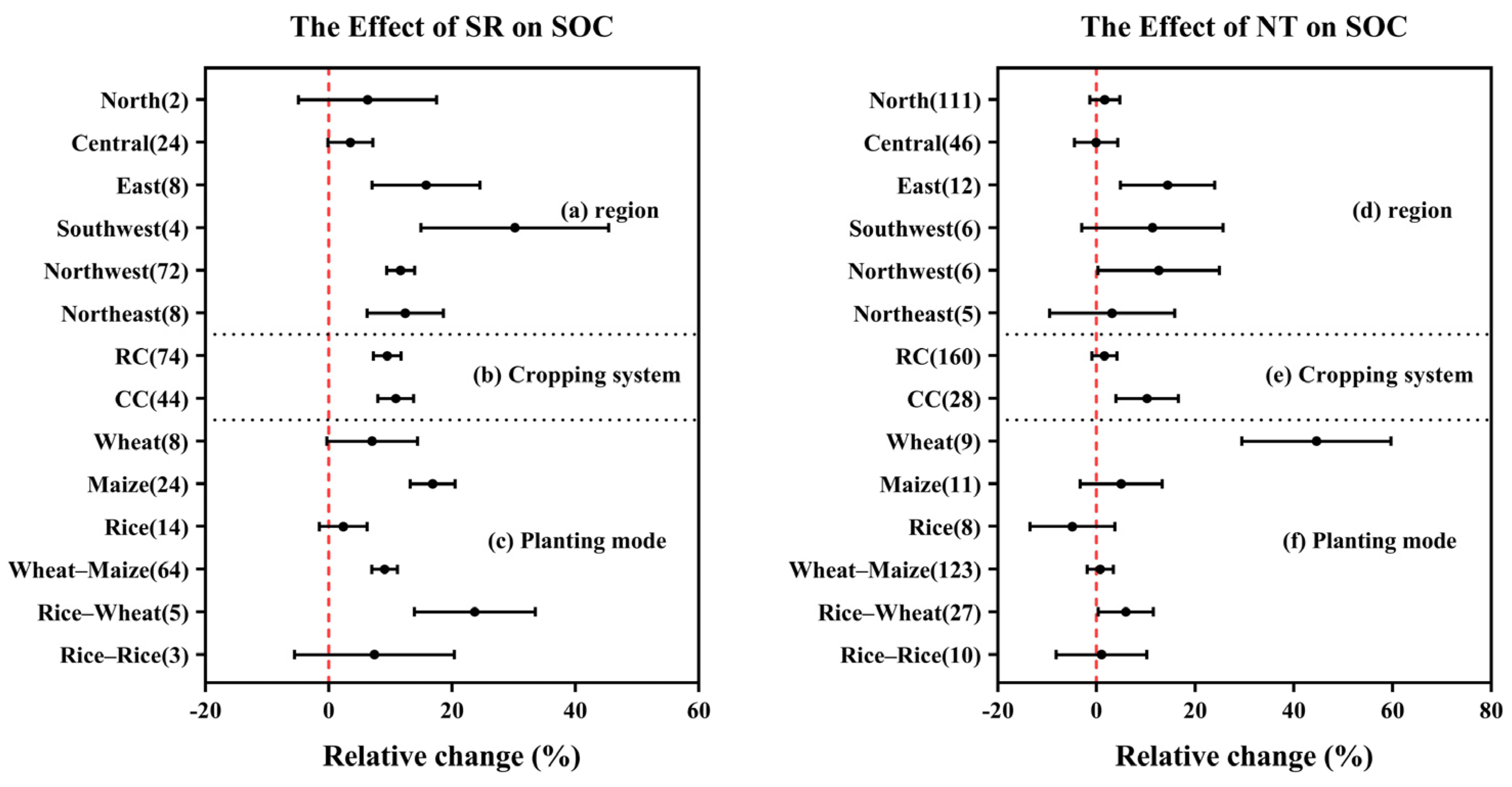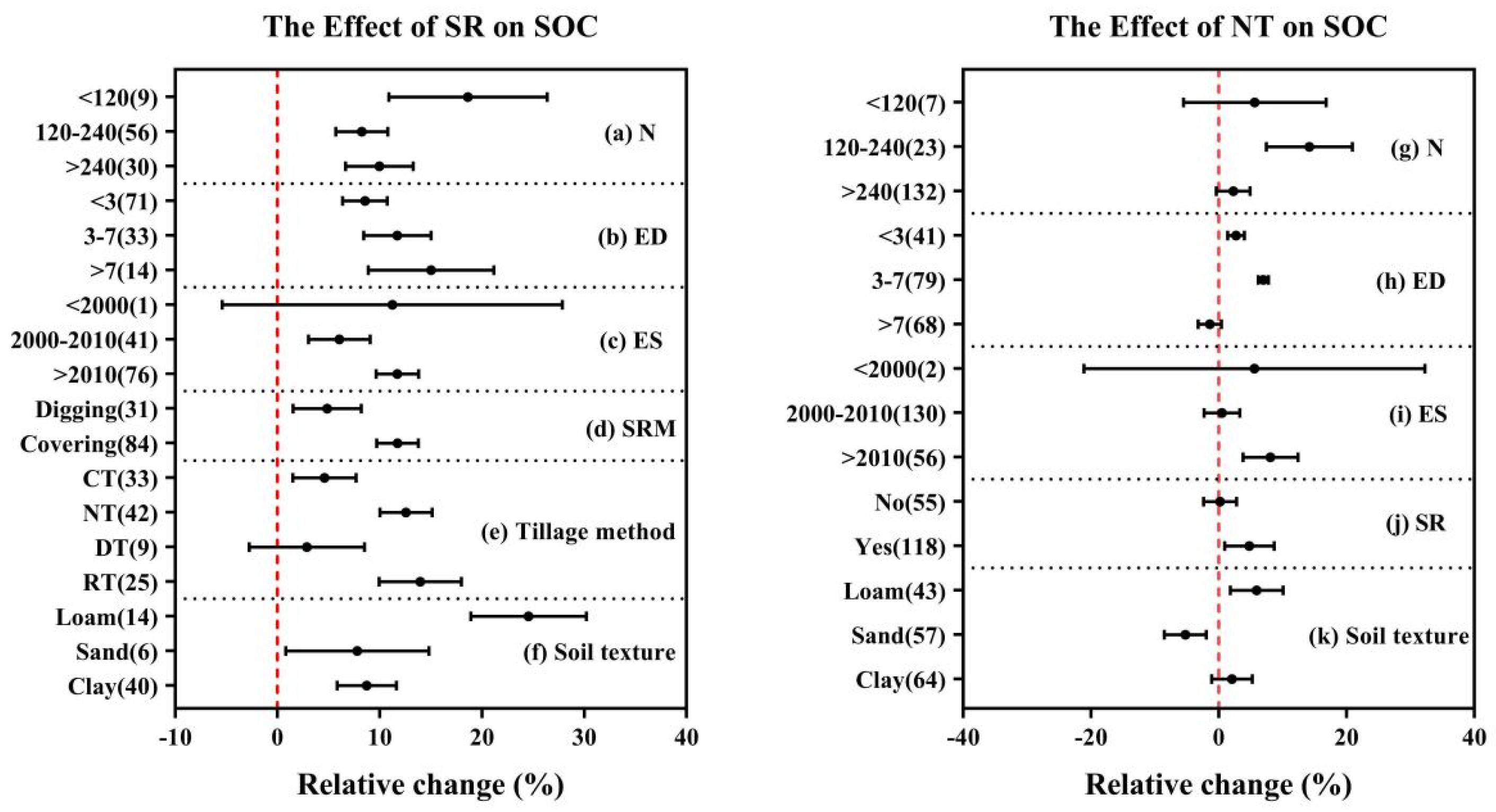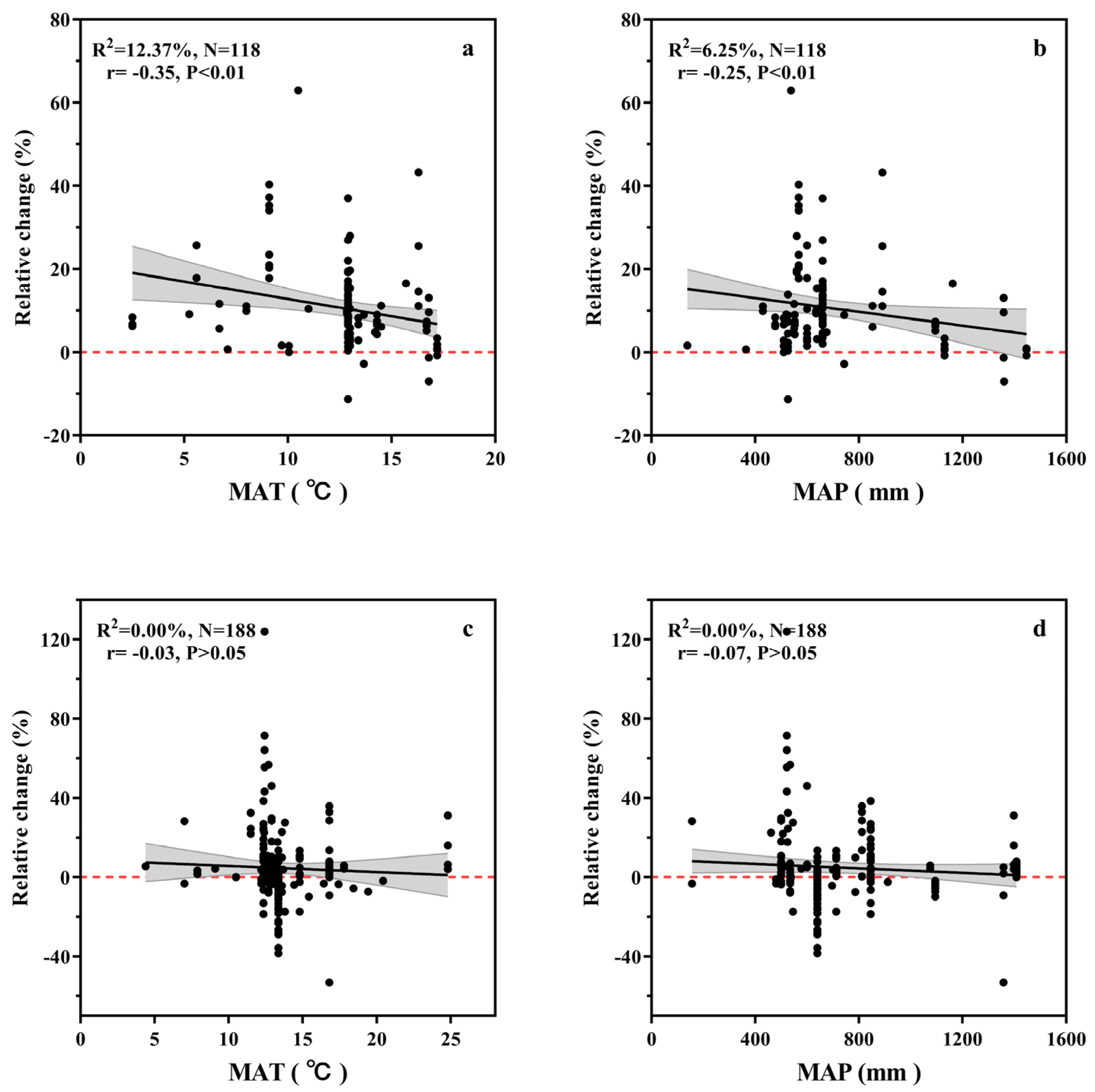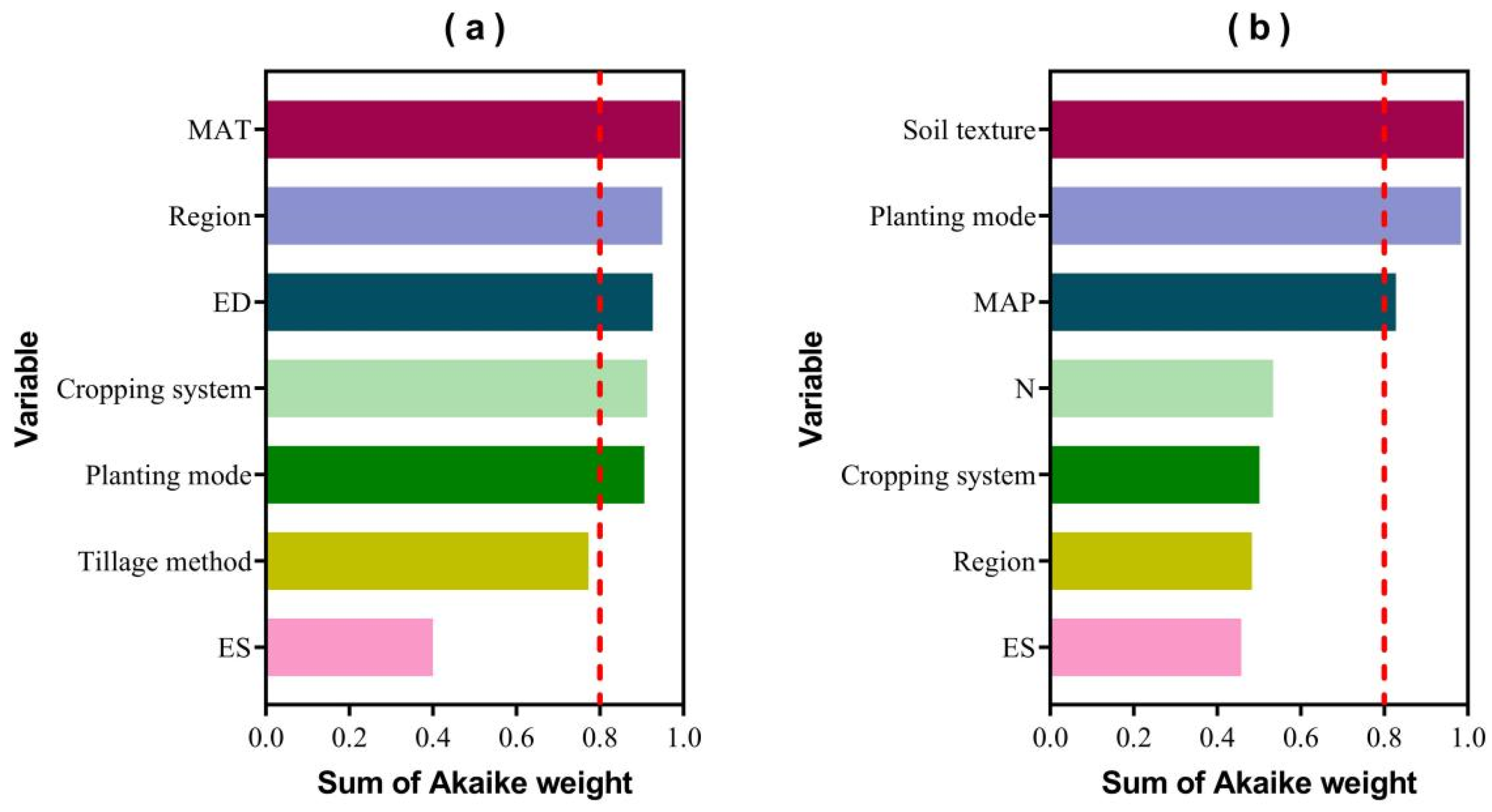Straw Return or No Tillage? Comprehensive Meta-Analysis Based on Soil Organic Carbon Contents, Carbon Emissions, and Crop Yields in China
Abstract
:1. Introduction
2. Materials and Methods
2.1. Data Collection
2.2. Data Categorization
2.3. Meta-Analysis
3. Results
3.1. Overall Effects of Tillage Practices
3.2. Differences in SOC Contents among Regions and Field Management Conditions
3.3. Responses of SOC Contents to Environmental Factors
3.4. Relative Importance of Effects on SOC Contents under SR and NT
4. Discussion
4.1. Overall Impacts on Farming Practices
4.2. Effects of Field Management Measures on SOC Contents
4.3. Effects of Climate Conditions on SOC Contents
4.4. Effects of Soil Properties on SOC Contents
4.5. Limitations of Meta-Analysis
5. Conclusions
Supplementary Materials
Author Contributions
Funding
Data Availability Statement
Acknowledgments
Conflicts of Interest
References
- Xu, E.; Zhang, H.; Xu, Y. Exploring land reclamation history: Soil organic carbon sequestration due to dramatic oasis agriculture expansion in arid region of Northwest China. Ecol. Indic. 2020, 108, 105746. [Google Scholar] [CrossRef]
- Zhou, Y.; Hartemink, A.E.; Shi, Z.; Liang, Z.; Lu, Y. Land use and climate change effects on soil organic carbon in North and Northeast China. Sci. Total Environ. 2019, 647, 1230–1238. [Google Scholar] [CrossRef] [PubMed]
- Song, G.H.; Li, L.Q.; Pan, G.X.; Zhang, Q. Topsoil organic carbon storage of China and its loss by cultivation. Biogeochemistry 2005, 74, 47–62. [Google Scholar] [CrossRef]
- Cai, Z.C. Effect of land use on organic carbon storage in soils in eastern China. Water Air Soil Pollut. 1996, 91, 383–393. [Google Scholar] [CrossRef]
- Song, K.; Zheng, X.; Lv, W.; Qin, Q.; Sun, L.; Zhang, H.; Xue, Y. Effects of tillage and straw return on water-stable aggregates, carbon stabilization and crop yield in an estuarine alluvial soil. Sci. Rep. 2019, 9, 4586. [Google Scholar] [CrossRef]
- Wu, H.B.; Guo, Z.T.; Peng, C.H. Distribution and storage of soil organic carbon in China. Glob. Biogeochem. Cycles 2003, 17, 1048. [Google Scholar] [CrossRef]
- Li, T.; Zhang, H.; Wang, X.; Cheng, S.; Fang, H.; Liu, G.; Yuan, W. Soil erosion affects variations of soil organic carbon and soil respiration along a slope in Northeast China. Ecol. Process. 2019, 8, 28. [Google Scholar] [CrossRef]
- Guo, L.; Zhang, L.; Liu, L.; Sheng, F.; Cao, C.; Li, C. Effects of long-term no tillage and straw return on greenhouse gas emissions and crop yields from a rice-wheat system in central China. Agric. Ecosyst. Environ. 2021, 322, 107650. [Google Scholar] [CrossRef]
- Wen, L.; Peng, Y.; Zhou, Y.; Cai, G.; Lin, Y.; Li, B. Effects of conservation tillage on soil enzyme activities of global cultivated land: A meta-analysis. J. Environ. Manag. 2023, 345, 118904. [Google Scholar] [CrossRef]
- Huang, T.; Yang, N.; Lu, C.; Qin, X.; Siddique, K.H.M. Soil organic carbon, total nitrogen, available nutrients, and yield under different straw returning methods. Soil Tillage Res. 2021, 214, 105171. [Google Scholar] [CrossRef]
- Guan, X.K.; Wei, L.; Turner, N.C.; Ma, S.C.; Yang, M.D.; Wang, T.C. Improved straw management practices promote in situ straw decomposition and nutrient release, and increase crop production. J. Clean. Prod. 2020, 250, 119514. [Google Scholar] [CrossRef]
- Yue, K.; Fornara, D.A.; Hedenee, P.; Wu, Q.; Peng, Y.; Peng, X.; Ni, X.; Wu, F.; Penuelas, J. No tillage decreases GHG emissions with no crop yield tradeoff at the global scale. Soil Tillage Res. 2023, 228, 105643. [Google Scholar] [CrossRef]
- Kan, Z.R.; Liu, W.X.; Liu, W.S.; Lal, R.; Dang, Y.P.; Zhao, X.; Zhang, H.L. Mechanisms of soil organic carbon stability and its response to no-till: A global synthesis and perspective. Glob. Chang. Biol. 2022, 28, 693–710. [Google Scholar] [CrossRef]
- Liu, W.M.; Liu, Y.E.; Liu, G.Z.; Xie, R.Z.; Ming, B.; Yang, Y.S.; Guo, X.; Wang, K.; Xue, J.; Wang, Y.; et al. Estimation of maize straw production and appropriate straw return rate in China. Agric. Ecosyst. Environ. 2022, 328, 107865. [Google Scholar] [CrossRef]
- Wang, H.; Jin, M.; Lu, C.; Shi, L.; Zhou, X.; Shen, M.; Ji, G.; Zhang, Y. Effects of patterns of returning straw to field on soil carbon pool and yield in Rice-wheat double cropping systems. J. Nat. Resour. 2017, 32, 755–764. [Google Scholar] [CrossRef]
- Liu, E.K.; Zhao, B.Q.; Mei, X.R.; So, H.B.; Li, J.; Li, X.Y. Effects of no-tillage management on soil biochemical characteristics in northern China. J. Agric. Sci. 2010, 148, 217–223. [Google Scholar] [CrossRef]
- He, J.; Li, H.; Rasaily, R.G.; Wang, Q.; Cai, G.; Su, Y.; Qiao, X.; Liu, L. Soil properties and crop yields after 11 years of no tillage farming in wheat-maize cropping system in North China Plain. Soil Tillage Res. 2011, 113, 48–54. [Google Scholar] [CrossRef]
- Huang, M.; Zhou, X.; Cao, F.; Xia, B.; Zou, Y. No-tillage effect on rice yield in China: A meta-analysis. Field Crops Res. 2015, 183, 126–137. [Google Scholar] [CrossRef]
- Li, Y.; Shi, S.; Waqas, M.A.; Zhou, X.; Li, J.; Wan, Y.; Qin, X.; Gao, Q.; Liu, S.; Wilkes, A. Long-term (≥20 years) application of fertilizers and straw return enhances soil carbon storage: A meta-analysis. Mitig. Adapt. Strateg. Glob. Chang. 2018, 23, 603–619. [Google Scholar] [CrossRef]
- He, C.; Niu, J.R.; Xu, C.T.; Han, S.W.; Bai, W.; Song, Q.L.; Dang, Y.P.; Zhang, H.L. Effect of conservation tillage on crop yield and soil organic carbon in Northeast China: A meta-analysis. Soil Use Manag. 2022, 38, 1146–1161. [Google Scholar] [CrossRef]
- Qi, G.; Kang, Y.; Yin, M.; Ma, Y.; Bai, Y.; Wang, J. Yield responses of wheat to crop residue returning in China: A meta-analysis. Crop Sci. 2019, 59, 2185–2200. [Google Scholar] [CrossRef]
- Smith, P.; Fang, C.; Dawson, J.J.C.; Moncrieff, J.B. Impact of global warming on soil organic carbon. Adv. Agron. 2008, 97, 1–43. [Google Scholar] [CrossRef]
- Chen, S.; Huang, Y.; Zou, J.; Shi, Y. Mean residence time of global topsoil organic carbon depends on temperature, precipitation and soil nitrogen. Glob. Planet. Chang. 2013, 100, 99–108. [Google Scholar] [CrossRef]
- Kirschbaum, M.U.F. The temperature dependence of organic-matter decomposition—Still a topic of debate. Soil Biol. Biochem. 2006, 38, 2510–2518. [Google Scholar] [CrossRef]
- Wang, X.; He, C.; Liu, B.; Zhao, X.; Liu, Y.; Wang, Q.; Zhang, H. Effects of residue returning on soil organic carbon storage and sequestration sate in China’s croplands: A meta-analysis. Agronomy 2020, 10, 691. [Google Scholar] [CrossRef]
- Berhane, M.; Xu, M.; Liang, Z.; Shi, J.; Wei, G.; Tian, X. Effects of long-term straw return on soil organic carbon storage and sequestration rate in North China upland crops: A meta-analysis. Glob. Chang. Biol. 2020, 26, 2686–2701. [Google Scholar] [CrossRef] [PubMed]
- FAO. FAO Statistical Databases. 2024. Available online: https://www.fao.org/ (accessed on 24 July 2024).
- Zhong, L.; Li, G.; Chen, G.; Wang, Y.; Chen, H.; Wu, W.; Li, J.; Song, Y.; Yan, B. Research progress on the distribution characteristics of crop straws and the preparation and application of straw carbon-based fertilizers in China. J. Agric. Resour. Environ. 2022, 39, 575–585. [Google Scholar] [CrossRef]
- Li, T.; Wang, Y.; Wang, J.; Li, L.; Xie, J.; Li, L.; Huang, X.; Xie, Y. Nutrient resource quantity from main grain crop straw incorporation and its enlightenment on chemical fertilizer reduction in wheat production in China. Sci. Agric. Sin. 2020, 53, 4835–4854. [Google Scholar] [CrossRef]
- Field, A.P.; Gillett, R. How to do a meta-analysis. Br. J. Math. Stat. Psychol. 2010, 63, 665–694. [Google Scholar] [CrossRef] [PubMed]
- Treseder, K.K. A meta-analysis of mycorrhizal responses to nitrogen, phosphorus, and atmospheric CO2 in field studies. New Phytol. 2004, 164, 347–355. [Google Scholar] [CrossRef]
- Luo, Y.Q.; Hui, D.F.; Zhang, D.Q. Elevated CO2 stimulates net accumulations of carbon and nitrogen in land ecosystems: A meta-analysis. Ecology 2006, 87, 53–63. [Google Scholar] [CrossRef]
- Nelson, D.W.; Sommers, L.E. Total carbon, organic carbon, and organic matter. In Methods of Soil Analysis. Part 3. Chemical Methods; SSSA Book Series No. 5; SSSA and ASA: Madison, WI, USA, 1996; pp. 961–1010. [Google Scholar] [CrossRef]
- Zhang, K.; Li, Y.; Wei, H.; Zhang, L.; Li, F.M.; Zhang, F. Conservation tillage or plastic film mulching? A comprehensive global meta-analysis based on maize yield and nitrogen use efficiency. Sci. Total Environ. 2022, 831, 154869. [Google Scholar] [CrossRef]
- WorldClim. WorldClim Website. 2024. Available online: http://www.worldclim.org/ (accessed on 13 April 2024).
- Feng, Z.; Wang, S.; Szantoi, Z.; Chen, S.; Wang, X. Protection of plants from ambient ozone by applications of ethylenediurea (EDU): A meta-analytic review. Environ. Pollut. 2010, 158, 3236–3242. [Google Scholar] [CrossRef]
- Hedges, L.V.; Gurevitch, J.; Curtis, P.S. The meta-analysis of response ratios in experimental ecology. Ecology 1999, 80, 1150–1156. [Google Scholar] [CrossRef]
- Zhao, H.; Ning, P.; Chen, Y.; Liu, J.; Ghaffar, S.A.; Tian, X.; Shi, J. Effect of straw amendment modes on soil organic carbon, nitrogen sequestration and crop yield on the North-Central Plain of China. Soil Use Manag. 2019, 35, 511–525. [Google Scholar] [CrossRef]
- Xia, L.; Lam, S.K.; Wolf, B.; Kiese, R.; Chen, D.; Butterbach-Bahl, K. Trade-offs between soil carbon sequestration and reactive nitrogen losses under straw return in global agroecosystems. Glob. Chang. Biol. 2018, 24, 5919–5932. [Google Scholar] [CrossRef]
- Liu, D.; Song, C.; Xin, Z.; Fang, C.; Liu, Z.; Xu, Y. Agricultural management strategies for balancing yield increase, carbon sequestration, and emission reduction after straw return for three major grain crops in China: A meta-analysis. J. Environ. Manag. 2023, 340, 117965. [Google Scholar] [CrossRef]
- Ul Islam, M.; Guo, Z.; Jiang, F.; Peng, X. Does straw return increase crop yield in the wheat-maize cropping system in China? A meta-analysis. Field Crops Res. 2022, 279, 108447. [Google Scholar] [CrossRef]
- Liu, S.; Gao, Y.; Lang, H.; Liu, Y.; Zhang, H. Effects of conventional tillage and no-tillage systems on Maize (Zea mays L.) growth and yield, soil structure, and water in loess plateau of China: Field experiment and modeling studies. Land 2022, 11, 1881. [Google Scholar] [CrossRef]
- Shao, Y.; Xie, Y.; Wang, C.; Yue, J.; Yao, Y.; Li, X.; Liu, W.; Zhu, Y.; Guo, T. Effects of different soil conservation tillage approaches on soil nutrients, water use and wheat-maize yield in rainfed dry-land regions of North China. Eur. J. Agron. 2016, 81, 37–45. [Google Scholar] [CrossRef]
- Xin, J.; Yan, L.; Cai, H. Response of soil organic carbon to straw return in farmland soil in China: A meta-analysis. J. Environ. Manag. 2024, 359, 121051. [Google Scholar] [CrossRef]
- Wang, J.; Wang, X.; Xu, M.; Feng, G.; Zhang, W.; Lu, C.a. Crop yield and soil organic matter after long-term straw return to soil in China. Nutr. Cycl. Agroecosyst. 2015, 102, 371–381. [Google Scholar] [CrossRef]
- He, Z.; Cao, H.; Qi, C.; Hu, Q.; Liang, J.; Li, Z. Straw management in paddy fields can reduce greenhouse gas emissions: A global meta-analysis. Field Crops Res. 2024, 306, 109218. [Google Scholar] [CrossRef]
- Du, Z.; Angers, D.A.; Ren, T.; Zhang, Q.; Li, G. The effect of no-till on organic C storage in Chinese soils should not be overemphasized: A meta-analysis. Agric. Ecosyst. Environ. 2017, 236, 1–11. [Google Scholar] [CrossRef]
- Pittelkow, C.M.; Liang, X.; Linquist, B.A.; van Groenigen, K.J.; Lee, J.; Lundy, M.E.; van Gestel, N.; Six, J.; Venterea, R.T.; van Kessel, C. Productivity limits and potentials of the principles of conservation agriculture. Nature 2015, 517, 365–368. [Google Scholar] [CrossRef]
- Bregaglio, S.; Mongiano, G.; Ferrara, R.M.; Ginaldi, F.; Lagomarsino, A.; Rana, G. Which are the most favourable conditions for reducing soil CO2 emissions with no-tillage? Results from a meta-analysis. Int. Soil Water Conserv. Res. 2022, 10, 497–506. [Google Scholar] [CrossRef]
- Qin, W.; Niu, L.; You, Y.; Cui, S.; Chen, C.; Li, Z. Effects of conservation tillage and straw mulching on crop yield, water use efficiency, carbon sequestration and economic benefits in the Loess Plateau region of China: A meta-analysis. Soil Tillage Res. 2024, 238, 106025. [Google Scholar] [CrossRef]
- Li, R.; Zheng, J.; Xie, R.; Ming, B.; Peng, X.; Luo, Y.; Zheng, H.; Sui, P.; Wang, K.; Hou, P.; et al. Potential mechanisms of maize yield reduction under short-term no-tillage combined with residue coverage in the semi-humid region of Northeast China. Soil Tillage Res. 2022, 217, 105289. [Google Scholar] [CrossRef]
- Abdalla, K.; Chivenge, P.; Ciais, P.; Chaplot, V. No-tillage lessens soil CO2 emissions the most under arid and sandy soil onditions: Results from a meta-analysis. Biogeosciences 2016, 13, 3619–3633. [Google Scholar] [CrossRef]
- Ul Islam, M.; Jiang, F.; Guo, Z.; Liu, S.; Peng, X. Impacts of straw return coupled with tillage practices on soil organic carbon tock in upland wheat and maize croplands in China: A meta-analysis. Soil Tillage Res. 2023, 2, 233–241. [Google Scholar] [CrossRef]
- Luo, Z.; Wang, E.; Sun, O.J. Can no-tillage stimulate carbon sequestration in agricultural soils? A meta-analysis of paired experiments. Agric. Ecosyst. Environ. 2010, 139, 224–231. [Google Scholar] [CrossRef]
- Xu, J.; Han, H.; Ning, T.; Li, Z.; Lal, R. Long-term effects of tillage and straw management on soil organic carbon, crop yield, and yield stability in a wheat-maize system. Field Crops Res. 2019, 233, 33–40. [Google Scholar] [CrossRef]
- Yang, H.; Li, J.; Wu, G.; Huang, X.; Fan, G. Maize straw mulching with no-tillage increases fertile spike and grain yield of dryland wheat by regulating root-soil interaction and nitrogen nutrition. Soil Tillage Res. 2023, 228, 105652. [Google Scholar] [CrossRef]
- Six, J.; Feller, C.; Denef, K.; Ogle, S. Soil organic matter, biota and aggregation in temperate and tropical soils-Effects of no-tillage. Agronomie 2002, 22, 755–775. [Google Scholar] [CrossRef]
- Liu, C.; Lu, M.; Cui, J.; Li, B.; Fang, C. Effects of straw carbon input on carbon dynamics in agricultural soils: A meta-analysis. Glob. Chang. Biol. 2014, 20, 1366–1381. [Google Scholar] [CrossRef]
- Lu, F. How can straw incorporation management impact on soil carbon storage? A meta-analysis. Mitig. Adapt. Strateg. Glob. Chang. 2015, 20, 1545–1568. [Google Scholar] [CrossRef]
- Zhang, Y.; Li, H.; Sun, Y.; Zhang, Q.; Liu, P.; Wang, R.; Li, J. Temporal stability analysis evaluates soil water sustainability of different cropping systems in a dryland agricultural ecosystem. Agric. Water Manag. 2022, 272, 107834. [Google Scholar] [CrossRef]
- Tian, S.Z.; Ning, T.Y.; Wang, Y.; Li, H.J.; Zhong, W.L.; Li, Z.J. Effects of different tillage methods and straw-returning on soil organic carbon content in a winter wheat field. J. Appl. Ecol. 2010, 21, 373–378. [Google Scholar] [CrossRef]
- Yang, J.H.; Luo, Y.; Chen, J.; Jin, M.; Wang, Z.L.; Li, Y. Effects of main food yield under straw return in China: A meta-analysis. China Agric. Sci. 2020, 53, 4415–4429. [Google Scholar] [CrossRef]
- Wang, S.; Wang, H.; Zhang, Y.; Wang, R.; Zhang, Y.; Xu, Z.; Jia, G.; Wang, X.; Li, J. The influence of rotational tillage on soil water storage, water use efficiency and maize yield in semi-arid areas under varied rainfall conditions. Agric. Water Manag. 2018, 203, 376–384. [Google Scholar] [CrossRef]
- Yu, Q.; Wang, H.; Wen, P.; Wang, S.; Li, J.; Wang, R.; Wang, X. A suitable rotational conservation tillage system ameliorates soil physical properties and wheat yield: An 11-year in-situ study in a semi-arid agroecosystem. Soil Tillage Res. 2020, 199, 104600. [Google Scholar] [CrossRef]
- Liu, Y.; Liu, R.; Ghimire, R.; Zhang, N.; Zhou, S.; Zhao, F.; Wang, J. Linking soil phosphorus fractions to associated microbial functional profiles under crop rotation on the Loess Plateau of China. Soil Tillage Res. 2023, 233, 105809. [Google Scholar] [CrossRef]
- Pradhan, A.; Chan, C.; Roul, P.K.; Halbrendt, J.; Sipes, B. Potential of conservation agriculture (CA) for climate change adaptation and food security under rainfed uplands of India: A transdisciplinary approach. Agric. Syst. 2018, 163, 27–35. [Google Scholar] [CrossRef]
- Jian, S.; Li, J.; Chen, J.; Wang, G.; Mayes, M.A.; Dzantor, K.E.; Hui, D.; Luo, Y. Soil extracellular enzyme activities, soil carbon and nitrogen storage under nitrogen fertilization: A meta-analysis. Soil Biol. Biochem. 2016, 101, 32–43. [Google Scholar] [CrossRef]
- Liu, X.; Tan, S.; Song, X.; Wu, X.; Zhao, G.; Li, S.; Liang, G. Response of soil organic carbon content to crop rotation and its controls: A global synthesis. Agric. Ecosyst. Environ. 2022, 335, 108017. [Google Scholar] [CrossRef]
- Deng, X.; Yang, Q.; Zhang, D.; Dong, S. Application of conservation tillage in China: A method to improve climate resilience. Agronomy 2022, 12, 1575. [Google Scholar] [CrossRef]
- Rahman, M.D.M.; Aravindakshan, S.; Hoque, M.A.; Rahman, M.A.; Gulandaz, M.A.; Rahman, J.; Islam, M.T. Conservation tillage (CT) for climate-smart sustainable intensification: Assessing the impact of CT on soil organic carbon accumulation, greenhouse gas emission and water footprint of wheat cultivation in Bangladesh. Environ. Sustain. Indic. 2021, 10, 100106. [Google Scholar] [CrossRef]
- Zheng, Z.M.; Yu, G.R.; Fu, Y.L.; Wang, Y.S.; Sun, X.M.; Wang, Y.H. Temperature sensitivity of soil respiration is affected by prevailing climatic conditions and soil organic carbon content: A trans-China based case study. Soil Biol. Biochem. 2009, 41, 1531–1540. [Google Scholar] [CrossRef]
- Hou, S.; Dou, S.; Liu, J.; Qu, X. Effects of temperature on dynamics of humus during corn stalk decomposition. Journal of Northwest A & F University. Nat. Sci. Ed. 2016, 44, 87–92. [Google Scholar] [CrossRef]
- Wittig, V.E.; Ainsworth, E.A.; Naidu, S.L.; Karnosky, D.F.; Long, S.P. Quantifying the impact of current and future tropospheric ozone on tree biomass, growth, physiology and biochemistry: A quantitative meta-analysis. Glob. Chang. Biol. 2009, 15, 396–424. [Google Scholar] [CrossRef]
- Zhang, H.; Xu, W.; Li, Y.; Lyu, J.; Cao, Y.; He, W. Changes of soil microbial communities during decomposition of straw residues under different land uses. J. Arid Land 2017, 9, 666–677. [Google Scholar] [CrossRef]
- Hashimi, R.; Kaneko, N.; Komatsuzaki, M. Impact of no-tillage on soil quality and crop yield in Asia: A meta-analysis. Land Degrad. Dev. 2023, 34, 1004–1018. [Google Scholar] [CrossRef]
- Wang, Y.; Xie, Y.; Ma, H.; Zhang, Y.; Zhang, J.; Zhang, H.; Luo, X.; Li, J. Responses of soil microbial communities and networks to precipitation change in a typical steppe ecosystem of the loess plateau. Microorganisms 2022, 10, 817. [Google Scholar] [CrossRef] [PubMed]
- Palm, C.; Blanco-Canqui, H.; DeClerck, F.; Gatere, L.; Grace, P. Conservation agriculture and ecosystem services: An overview. Agric. Ecosyst. Environ. 2014, 187, 87–105. [Google Scholar] [CrossRef]
- Sheng, Y.; Zhu, L. Biochar alters microbial community and carbon sequestration potential across different soil pH. Sci. Total Environ. 2018, 622, 1391–1399. [Google Scholar] [CrossRef] [PubMed]
- Singh, H.; Northup, B.K.; Rice, C.W.; Prasad, P.V.V. Biochar applications influence soil physical and chemical properties,microbial diversity,and crop productivity: A meta-analysis. Biochar 2022, 4, 8. [Google Scholar] [CrossRef]
- Xu, L.; He, N.; Yu, G. Methods of evaluating soil bulk density: Impact on estimating large scale soil organic carbon storage. Catena 2016, 144, 94–101. [Google Scholar] [CrossRef]
- Chai, H.; He, N. Evaluation of soil bulk density in Chinese terrestrial ecosystems for determination of soil carbon storage on a regional scale. Acta Ecol. Sin. 2016, 36, 3903–3910. [Google Scholar] [CrossRef]
- Zhang, X.; Wang, J.; Feng, X.; Yang, H.; Li, Y.; Yakov, K.; Liu, S.; Li, F.-M. Effects of tillage on soil organic carbon and crop yield under straw return. Agric. Ecosyst. Environ. 2023, 354, 108543. [Google Scholar] [CrossRef]
- Javed, A.; Ali, E.; Binte Afzal, K.; Osman, A.; Riaz, D.S. Soil fertility: Factors affecting soil fertility, and biodiversity responsible for soil fertility. Int. J. Plant Anim. Environ. Sci. 2022, 12, 21–33. [Google Scholar] [CrossRef]
- Wang, Y.; Wu, P.; Mei, F.; Ling, Y.; Qiao, Y.; Liu, C.; Leghari, S.J.; Guan, X.; Wang, T. Does continuous straw returning keep China farmland soil organic carbon continued increase? A meta-analysis. J. Environ. Manag. 2021, 288, 112391. [Google Scholar] [CrossRef]
- Kong, X.; Dao, T.H.; Qin, J.; Qin, H.; Li, C.; Zhang, F. Effects of soil texture and land use interactions on organic carbon in soils in North China cities’ urban fringe. Geoderma 2009, 154, 86–92. [Google Scholar] [CrossRef]
- Li, P.; Ying, D.; Li, J.; Deng, J.; Li, C.; Tian, S.; Zhao, G.; Wu, C.; Jiao, J.; Jiang, M.; et al. Global-scale no-tillage impacts on soil aggregates and associated carbon and nitrogen concentrations in croplands: A meta-analysis. Sci. Total Environ. 2023, 881, 163570. [Google Scholar] [CrossRef] [PubMed]






| Variable | SR | NT | ||||
|---|---|---|---|---|---|---|
| p Value | R2 (%) | r | p Value | R2 (%) | r | |
| SOC | <0.05 * | 3.72 | −0.19 | 0.63 | 0.00 | −0.04 |
| SOM | <0.05 * | 4.93 | −0.22 | 0.43 | 0.00 | −0.05 |
| pH | <0.01 ** | 61.71 | 0.79 | <0.01 ** | 59.68 | 0.77 |
| BD | 0.06 | 24.92 | 0.50 | <0.01 ** | 48.73 | 0.70 |
| Soil texture | <0.01 ** | 32.41 | <0.01 ** | 11.31 | ||
Disclaimer/Publisher’s Note: The statements, opinions and data contained in all publications are solely those of the individual author(s) and contributor(s) and not of MDPI and/or the editor(s). MDPI and/or the editor(s) disclaim responsibility for any injury to people or property resulting from any ideas, methods, instructions or products referred to in the content. |
© 2024 by the authors. Licensee MDPI, Basel, Switzerland. This article is an open access article distributed under the terms and conditions of the Creative Commons Attribution (CC BY) license (https://creativecommons.org/licenses/by/4.0/).
Share and Cite
Yan, Y.; Li, H.; Zhang, M.; Liu, X.; Zhang, L.; Wang, Y.; Yang, M.; Cai, R. Straw Return or No Tillage? Comprehensive Meta-Analysis Based on Soil Organic Carbon Contents, Carbon Emissions, and Crop Yields in China. Agronomy 2024, 14, 2263. https://doi.org/10.3390/agronomy14102263
Yan Y, Li H, Zhang M, Liu X, Zhang L, Wang Y, Yang M, Cai R. Straw Return or No Tillage? Comprehensive Meta-Analysis Based on Soil Organic Carbon Contents, Carbon Emissions, and Crop Yields in China. Agronomy. 2024; 14(10):2263. https://doi.org/10.3390/agronomy14102263
Chicago/Turabian StyleYan, Yanfei, Haoyu Li, Min Zhang, Xiwei Liu, Lingxin Zhang, Yaokuo Wang, Min Yang, and Ruiguo Cai. 2024. "Straw Return or No Tillage? Comprehensive Meta-Analysis Based on Soil Organic Carbon Contents, Carbon Emissions, and Crop Yields in China" Agronomy 14, no. 10: 2263. https://doi.org/10.3390/agronomy14102263





